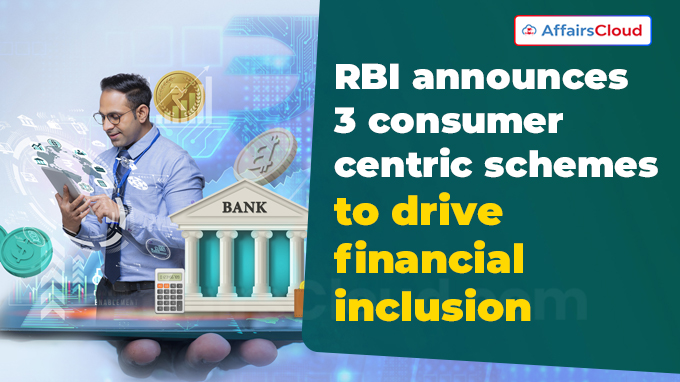
In August 2025, Sanjay Malhotra, Governor of the Reserve Bank of India (RBI) announced 3 schemes aimed to boost financial inclusion among consumers during his address following the conclusion of 3rd bi-monthly Monetary Policy Committee (MPC) meeting of Financial Year 2025-26 (FY26) was held in Mumbai, Maharashtra.
- The newly announced consumer-centric schemes include: simplified Re-Know Your Customer (KYC) procedures ; streamlined claims for deceased account holders; and enhanced features on the Retail Direct Platform for Government Securities (G-Secs).
- These reforms aimed at enhancing financial access, simplifying banking processes, and bolstering the reach of government-supported financial inclusion schemes.
Exam Hints:
- What? Announcement of 3 consumer-centric schemes
- Announced by: Sanjay Malhotra, RBI Governor
- 3 Consumer-centric schemes: simplified Re-KYC procedures ; streamlined claims for deceased account holders; and enhanced features on the Retail Direct Platform for G-Secs
- Doorstep Bank Campus : July 01, 2025 to September 30, 2025
About 3 Consumer-Centric Schemes:
Rural Re-KYC and Financial Progress:
Conducting doorstep banking camps: As per RBI directions, all banks will conduct doorstep banking camps from July 01, 2025 to September 30, 2025 at Panchayat level.
- The RBI announced a major outreach campaign for rural and unbanked populations to commemorate 10 years of the Pradhan Mantri Jan Dhan Yojana (PMJDY).
Key Focus Areas: These banking camps focus mainly on: Re-KYC for account holders of PMJDY; opening new bank accounts; enrolling beneficiaries in micro-insurance and pension schemes such as: Pradhan Mantri Jeevan Jyoti Bima Yojana (PMJJBY), Pradhan Mantri Suraksha Bima Yojana (PMSBY), and Atal Pension Yojana (APY); and resolving customer grievances’ on-site.
Key Progress: As per RBI’s data released in August 2025, during the 1st month of doorstep banking camps, which started on July 01, 2025, witnessed 1.05 lakh camps being conducted in the Gram Panchayats (GPs).
- During this same time period, over 6 lakh PMJDY accounts were opened, and 7 lakh+ enrolments under PMJJBY took place, with nearly 12 lakh enrolments under PMSBY and 3 lakh enrolments under APY.
- Additionally, Re-KYC of 14.22 lakh bank accounts has been done through the camp mode.
Simplified Settlement Process for Deceased Customers:
Objective: Banks have been directed to simplify the claim settlement process for deceased account holders under the Banking Regulation Act, 1949.
New Framework: The RBI is expected to soon release a draft circular for public consultation to streamline and standardize the settlement procedure and will cover: deposit accounts, articles held in safe custody, and safe deposit locker contents.
Expanding Functionality of RBI Retail:
Objective: RBI plans to expand the functionality of its retail direct platform to allow retail investors to invest in Treasury Bills (T-Bills) through Systematic Investment Plans (SIPs).
- This move is expected to simplify G-Secs investment for individual investors.
- T-Bills are short-term debt instruments issued by the Government of India (GoI) to meet the temporary liquidity demands, with maturity time periods of 14, 91, 182, and 364 days.
Retail Direct Platform: It was launched by RBI in November 2021, to help retail investors open Gilt accounts directly with the RBI under the Retail Direct Scheme (RDS).
- The scheme allows individuals to participate in primary auctions of G-Secs and also trade them in the secondary market.
Recent Related News:
In June 2025, RBI released India’s International Investment Position (IIP) data. As per the data, over 72% of the total growth in India’s foreign financial assets during the FY25 was mainly driven by higher overseas direct investments, currency & deposits, and reserve assets.
- The data further revealed that reserve assets alone accounted for over 54% increase in Indian residents’ overseas financial assets; followed by currency & deposits and direct investments.




